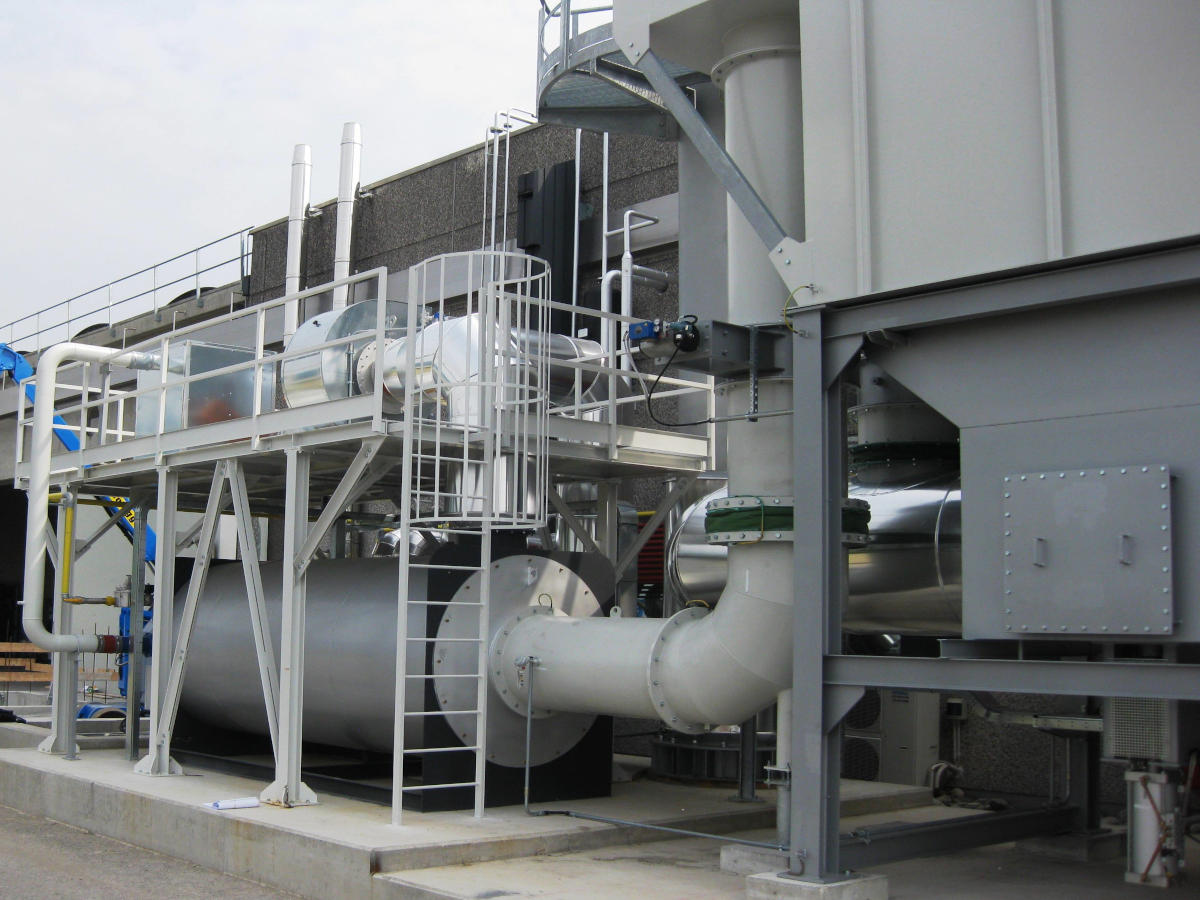How to maximize the effectiveness of pollutant combustion to support productive machine operation
THE DRYING PROCESSES OF SUPPORTS PRINTED WITH SOLVENT-BASED INKS IN THE CONVERTING SECTOR, REQUIRE THERMAL ENERGY WHICH IS OFTEN PROVIDED BY USING DIATHERMIC OIL AS A HEAT SOURCE; THE EVAPORATION OF THE SOLVENTS GENERATED IN THE DRYING PROCESS CREATES AN ATMOSPHERIC EMISSION THAT CAN BE PURIFIED BY INSTALLING A REGENERATIVE THERMAL OXIDIZER.

THE ENVIRONMENTAL AND ENERGY IMPACT OF THE DRYING PROCESSES OF SUPPORTS PRINTED WITH SOLVENT-BASED INKS
The printing of substrates with solvent-based inks is used to produce plastic, paper or laminated materials used in the converting sector for the creation of flexible packaging. The application of inks on flexible supports can be done with rotogravure, flexography, or lacquering processes. Each of these processes involves one or more drying sections, in which the solvents used for the application of the inks are evaporated in a drying air stream that is emitted into the atmosphere with suitable ventilation systems. Emissions into the atmosphere therefore contain Volatile Organic Compounds (V.O.C.) generating olfactory nuisance and environmental pollution. In drying processes, the drying air is heated often using diathermic oil as a fluid for heat transfer.
THE CHARACTERISTICS OF THE EMISSIONS
The atmospheric emissions deriving from the converting processes have the following characteristics:
| VARIABLE | CHARACTERISTICS |
|---|---|
| Temperature | 40-70°C, depending on the substrate used and the required drying temperature |
| Presence of volatile organic compounds (V.O.C.) | Alcohols and esters |
| Flow rates of emitted air | Highly variable, depending on the number of production machines installed, the printing width and the number of printing units present on each machine |
| Concentration of Volatile Organic Compounds (V.O.C.) | High, thanks to the presence of recirculation systems and concentration of pollutants present in production machinery |
| Operation cycle | On several daily shifts |
DEPURATION AND ENERGY RECOVERY GOALS
Depuration goals are mainly to reduce dangerous VOC emissions into the atmosphere, respecting the foreseen limits for each pollutant, without creating secondary pollutants and with acceptable capital and handling costs while recovering usable energy directly in the production process that generates the emission.
THE SOLUTION THROUGH THE REGENERATIVE THERMAL OXIDATION PROCESS WITH HEAT RECOVERY INTEGRATED IN THE HEAT GENERATOR
To resolve the environmental problem and obtain an interesting energy recovery, regenerative thermal oxidation was combined with a heat generator capable of exploiting the excess energy generated in the oxidation process.
Regenerative thermal oxidation is a chemical process that allows – with high temperature and the oxygen normally contained in the emissions – the transformation of organic pollutants into sub-products with reduced environmental impact: water and carbon dioxide.
Since the conversion needs a temperature up to 800-900°C, we foresee a particularly efficient energy recovery which – thanks to the use of specific ceramic filling materials – can limit operating costs bound to the use of auxiliary fuel feeding a dedicated burner.
In this application, the content of pollutants present is so high that the heat generated during the oxidation of Volatile Organic Compounds allows the oxidizer to work in autothermal mode. The heat is also available in excess to allow the heating of the diathermic oil used for the drying air in the printing machine. The heat generator therefore works not only using a traditional fuel (natural gas), but also by exploiting the heat present in the oxidizer combustion fumes.
CONSIDERATIONS FOR THE APPLICATION IN THE CONVERTING INDUSTRY
Regenerative thermal oxidation is a process frequently used for the treatment of atmospheric emissions containing vocs released in converting processes, characterized by the need to treat variable air flows and high quantities of pollutants; in this case, it has been combined with a heat generator integrated with the oxidator. this combination allows to recover in the production process the excess of heat generated by the reaction of thermal oxidation of the pollutants.
The application in the converting industry had to foresee specific aspects, aimed at reaching the following goals:
- The achievement of the highest purification performances, through a specific sizing of the process parameters
- The optimization of heat recovery, thanks to the construction of a heat generator capable of using the excess energy contained in the combustion fumes, but also to operate with traditional fuel
- The flexibility of being able to guarantee the thermal needs of the production process even if the concentration of pollutants is not sufficient to support the energy demand
- The reliability of operation, in order to constantly guarantee both the abatement of pollutants and the generation of the thermal needs of the production process over time.
THE RESULTS
The installed RTO is characterized by high energy recovery which not only allows it to operate in autothermal mode (without the need of support fuel) but can also be used to heat the diathermic oil of the drying process. It is therefore possible not only to purify the emission from the solvent content, but also significantly reduce the energy and environmental impact of the production process, with an interesting return of the investment and a reduction in CO2 production.
The results obtained applying the combination of these technologies confirm the quality of the solution:
- Pollutant concentration values that are way lower than the ones foreseen by law
- The reduction of the formation of secondary pollutants not only in the oxidation process, but also in the heat generation process
- The containment or even the cancellation of the management costs of the production process
- No interference with the productive processes upstream the depuration plant
- The economic return of the investment in an advantageous period of time